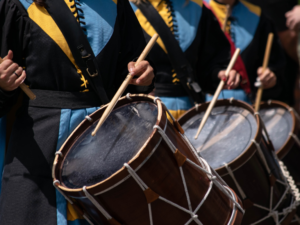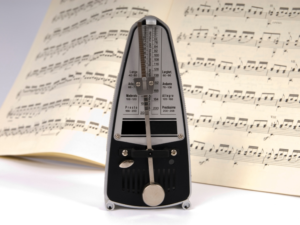The question above has a couple of different answers. First and foremost, rhythm is necessary just to get you through your day. Without it, you wouldn’t be able to walk or chew gum, let alone do both at the same time. You wouldn’t even be able to breathe. Because rhythm, it turns out, is vital to our very survival. In the words of one study, “The cerebellar output is rhythmically modulated and provides phasic drive to the fast-descending pathways.”
Or, as Bjork put it, “The mind and body can’t help getting in sync.”
Sync and Swim
OK. So the connection that allows your body to magically do what your brain commands is one type of rhythm. But for a musician, rhythm has a more specific definition — even if it remains frustratingly abstract. It is not, for example, just a matter of “keeping the beat” — although beat is certainly a big part of it. But rhythm is also the pauses in between the beats, and the pattern of beats and pauses that emerges over a given time. “Think of the beat as the music’s skeleton,” Steve Benedetto writes in Making Music Mag.com. It is “the pace, tempo or the timing that it takes to play a particular piece of music.”
Rhythm, on the other hand, “can be thought of as how you inhabit the beat. … In essence, a music piece’s beat is its unchanging tempo, while the rhythm is a pattern in which a piece’s notes flow.”
Noteworthy Differences
While it’s possible for a group of gifted musicians to intuitively grasp a piece’s rhythmic flow, most performers need guidance. Think of those rhythmic notations on a piece of sheet music — the time signatures, the rests, and the different durations of notes — as a kind of musical GPS that helps keep the performers on course so they all end up in the same place. “Without rhythm, most of the music we hear and love would sound disjointed, aimless, and impossible to follow,” songwriter Patrick McGuire notes on Musika.
Understanding notations in order to play in rhythm is one of the primary reasons that budding musicians should learn to read music. The most common rhythmic notation is the time signature, and the most common time signature is 4/4.
What does “4/4” mean? The top “4” signifies that there are four beats per measure, while the bottom “4” signifies that there are four quarter notes in that measure. Note values commonly range from whole notes to sixteenth notes, although some composers use even smaller values, including the remarkable 1024th notes in Toccata Grande Cromatica by Anthony Philip Heinrich. Not only is it a challenge to try to play 1024th notes, it’s hard to even get the notations to fit within the measure.
Speaking of which: What exactly is a measure? “A measure in music is simply the short sections or boxes of musical notes we see in music notation,” McGuire writes. “On pitched instruments, rhythm notation will be written on various lines on the staff. Musicians playing non-pitched instruments read notes from a singular line of music because they don’t need to bother with reading different lines for different pitches.”
Rests, as the name suggests, indicate when a performer should stay silent and for how long. Rest durations are expressed in the same way as note durations: whole, half, quarter, etc.
Taken together, time signatures, notes, rests, and other rhythmic notations create a sort of recipe that tells you how the piece should be played.
That’s the Theory — What About the Practice?
As in every other aspect of musicianship, practice in rhythm reading makes perfect (or at least proficient). Start with the basics. Clapping exercises, for example, are an especially good way to make the concept of rhythm comprehensible to kids.
Another classic way to convey rhythm is to use a metronome. If your meter isn’t exact — and it probably isn’t — a  metronome will keep you in time. Precision counts, and even experienced musicians find that a metronome helps keep them in time as they practice.
metronome will keep you in time. Precision counts, and even experienced musicians find that a metronome helps keep them in time as they practice.
Other methods for staying in rhythm include counting out loud, although McGuire acknowledges that “a lot of people might feel silly doing this.” (For an example of why counting out loud can be both effective and silly, listen to Lawrence Welk’s “A-One A-Two A-Cha Cha Cha.”)
Overcoming self-consciousness is a big part of learning to play in rhythm — and to play like a true musician. As McGuire notes, “Real musicians consistently mark their sheet music with a pencil to help them be able to read and understand tough passages of rhythm.”
The goal is to avoid the ultimate self-consciousness: to be out of rhythm with everyone else. And the best way to ensure that never happens is to practice, practice, practice. Stick with those rhythm exercises, and you’ll find that, as Bjork said, “The mind and body can’t help getting in sync.”
Back To Top